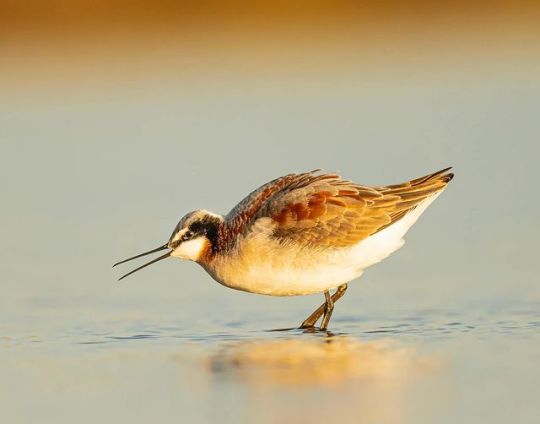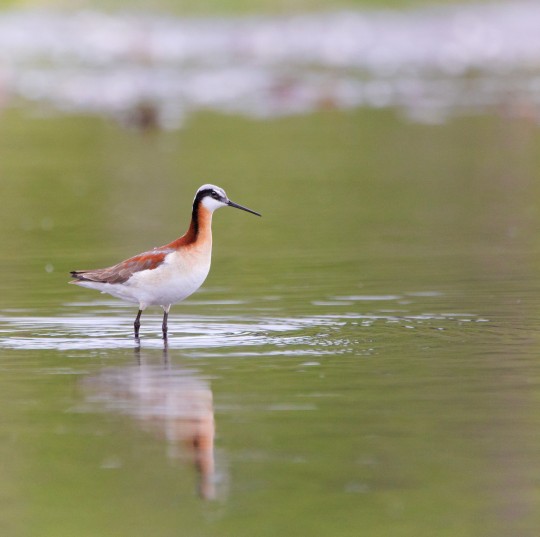#wilsons phalarope
Explore tagged Tumblr posts
Text


New lifer for me: Wilson's phalarope!
#ndr#find me where the wild things are#birds my beloved#wilsons phalarope#i thought pharalopes were bigger birds like just slightly smaller than ducks#but theyre actually teeny tiny little guys#smaller than a blackbird!#just little guys!
53 notes
·
View notes
Photo

Wilson’s Phalarope
42 notes
·
View notes
Text










My first pelagic! There were tons of other birds but I had trouble taking pictures. My setup isn’t fitted for this kind of birding haha
(8-24-24)
#take.flight#my photography#birding#wildlife photography#wilsons storm petrel#wilsons phalarope#northern gannet
0 notes
Text
BOTD: Wilson's Phalarope

Photo: Mick Thompson
"Phalaropes reverse the usual sex roles in birds: Females are larger and more colorful than males; females take the lead in courtship, and males are left to incubate the eggs and care for the young. Wilson's Phalarope is an odd shorebird that swims and spins on prairie marshes. The other two species of phalaropes nest in the Arctic and winter at sea, but Wilson's is a bird of inland waters, nesting mostly on the northern Great Plains. Huge numbers may gather in fall on some salty lakes in the west, such as Mono Lake and Great Salt Lake, before migrating to South America."
- Audubon Field Guide
#birds#wilson's phalarope#birds of north america#north american birds#phalaropes#sandpipers#waders#wading birds#shorebirds#birds of the us#birds of canada#birds of mexico#birds of central america#birds of the caribbean#birding#bird watching#birdblr#birblr#bird of the day#Phalaropus tricolor
51 notes
·
View notes
Text


a pair of wilson's phalaropes! somewhat rare in my area, so it was very lucky that I got to see them twice in 3 days (。^ᴗ^ )
interestingly, the females are the bolder ones in these birds! such an elegant pair ( ˙꒳˙ )
593 notes
·
View notes
Text
Excerpt from this story from Inside Climate News:
To complete a nonstop 4,000-mile flight, Wilson’s phalarope needs fuel.
The tiny inland shorebird famed for its reversed gender roles often finds that food in the Great Salt Lake. Upwards of 250,000 of the birds, a third of the species’ total population, will find their way to the country’s largest saline lake in the coming months to fill up on an almost endless supply of alkali flies, brine flies and brine shrimp. During that period, Wilson’s phalaropes will double their size and molt their feathers for a new coat, preparing them to travel south to Argentina for the winter.
But the pit stop needed to complete that journey is on the verge of collapse. For decades, the lake has received too little fresh water from the three rivers that feed it, largely due to agricultural operations diverting too much of their flow. That’s resulted in half of the lake’s surface area drying up, while the actual volume of water has dropped by around 70 percent. Less fresh water entering the lake means the salinity levels are rising, threatening the reproductivity of the invertebrates that feed Wilson’s phalarope and the millions of birds that come to the lake. Already, some sections of the lake are functionally dead after being cut off from the main body of water.
As part of an effort to save the lake and all that depends on it, a coalition of environmentalists and scientists filed a petition with the U.S. Fish and Wildlife Service last month to have Wilson’s phalarope listed as threatened under the Endangered Species Act. It’s a move that kicks off a years-long process that could force federal intervention to save the bird. Or it could force Utah and its neighboring states to devise their own conservation plan for the lake and Wilson’s phalarope to avoid federal involvement to protect the species.
“Our point is not to get a species on a list,” said Patrick Donnelly, the Great Basin director for the Center for Biological Diversity, which led the push for the petition. “Our point is to prevent extinction.”
10 notes
·
View notes
Text

Another (spinning!) girlboss and a classic shorebird.
Wilson’s phalaropes are migratory, breeding in the prairies of western North America and wintering in inland salt lakes in western South America. They feed by spinning around to create a vortex in the water, which stirs up invertebrates from the bottom of the water. Unusually for birds, the females of this species are larger and more colorful. During the breeding season, a female will court several males consecutively and lay several clutches with different fathers. Females compete for nesting territory as well as defend their nests and mates. Once a female lays her eggs, she will leave them in the care of the father and move on to find a new male.
Sanderlings live along the sandy beaches of much of the world and breed on the high Arctic tundra. They mostly eat small crabs and other invertebrates, which they pick out of the sand with their narrow beaks. They chase the surf as it retreats, because the sand is softer at this time and they can more easily catch hiding invertebrates. During breeding season, males defend their nesting territory. Sanderlings may form monogamous pairs or polyandrous systems.
11 notes
·
View notes
Text
little creature of the day: Wilson's Phalarope

I like when they swim in little circles
image source
5 notes
·
View notes
Text



A pair of beautiful and distinctive Wilson's Phalarope (she's more beautiful than he, if you ask me—he looks not too dissimilar to other sandpipers) wading along the shore of a pond.
photos by me. 2023-05-13 Outside of Vulcan, AB. cross-posted to the Cornell Lab of Ornithology's Macaulay Library.
Phalaropus tricolor
#mine#Phalaropus tricolor#bird#birds#wilson's phalarope#birding#birdwatching#birb#birdblr#birblr#shore birds#nature photography#ornithology
3 notes
·
View notes
Video
Beautiful Sunny Morning Swim - Wilson's Phalarope by Georgie Alexon Via Flickr: This Wilson's Phalarope photograph was taken in Alberta, Canada on a sunny spring day. He was out swimming in circles on a lake looking for his next meal. These birds forage for food in a unique way. This species swims around in circles creating a whirlpool. This agitates any small aquatic invertebrate and algae from the substrate of a pond or lake and brings it to the surface. This species of bird also forages in the mud surrounding the pond or lake for prey. Wilson's phalaropes will probe their bill into the mud or stand still and snatch flying insects out of the air. Wilson's phalaropes rarely pursue prey while in flight. -Phalaropus tricolor
#bird#oiseaux#wilsons#phalarope#alberta#canada#canon#eos#day#photo#photography#calm#outside#countryside#white#red#orange#water#blue#lake#wildlife#animal#nature#colors#Phalaropus tricolor#Scolopacidae#morning#flickr
2 notes
·
View notes
Text
Please, I beg of you. Listen to their sounds and watch them go spinny-mode in the water to make little whirlpools.

wilson's phalarope
3K notes
·
View notes
Text
got to see me some cedar waxwings today (even if from relatively far) and thought i would be more bummed that we didn’t find where the flock went, but instead i’m going bonkers trying to figure out what yellow-legged vaguely two-tone shore bird we saw
#current guess: wilson’s phalarope? nothing else makes sense and the Shape is right#i’ve been perseverating on this bird for HOURS LMFAO
0 notes
Text

wilson's phalarope (Phalaropus tricolor) by Raphael Kurz
1 note
·
View note
Note
I would like to trouble you once more with a request of animals for which the female is either larger or more brightly colored than the male, such as the Wilson's Phalarope or the Eclectus parrot
Sure thing!
Of course, with most spiders, the females are larger. As with ladybird spiders...

Ladybird Spider (Eresus moravicus), female, family Eresidae, northern Italy
photograph by lynko

Ladybird Spider (Eresus moravicus), male, family Eresidae, Hungary
Male ladybird spiders mimic ladybird beetles (ladybugs), while the larger females do not.
photograph by Walter Pfliegler


Greater Painted-Snipe (Rostratula benghalensis), male (back) and female (front), family Rostratulidae, Pathum Thani Rice Research Center, Thailand
Females are more colorful than the males. The females court the males, and are polyandrous (having multiple mates). The males incubate the nest and raise young.
photograph by Sani Sansanee & Arkajit Chakraborty


With many snakes, the females are larger, as with garter snakes...
Red-sided Garter Snakes (Thamnophis sirtalis parietalis), family Colubridae, outside a den in Manitoba, Canada
photograph by Elise Watchorn
Garter snakes make friends, organize their society around females
Read more: https://www.science.org/content/article/garter-snakes-make-friends-organize-their-society-around-females

For many species of Aquatic Turtle, the females are also larger...
Northern Map Turtle (Graptemys geographica), family Emydidae, NE United States
photograph by turtleconservancy
361 notes
·
View notes
Text

Wilson’s Phalarope (Phalaropus tricolor), Willcox, Cochise County, Arizona.
88 notes
·
View notes
Text

The Red-Necked Phalarope is day 19 of #migratorymay2024 hosted by @migratorymay and @environmentamericas Pictured are all three #phalaropes - Red-Necked, Wilson's and Red. #migratorymay
155 notes
·
View notes